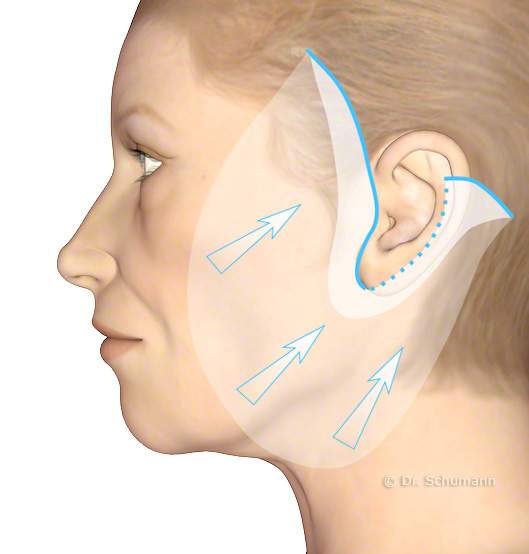A facelift (facelift, face lift, rhytidectomy) is still the most effective method for tightening facial skin. It is only possible to correct massive excess skin on the face surgically.
The reason for a facelift is usually age-related sagging of the facial skin. This can be more pronounced in smokers, sun worshippers or after significant weight loss and can occur much earlier.
In the cases described, the skin can be massively pre-aged, which is why those affected can no longer identify with their face.
A facelift is also rarely performed in the case of illnesses. These include, for example, accidents or operations that lead to facial injuries and paralysis of the facial nerve, which can result in facial imbalance.
Contents
Yuveo Clinic
Special features of the facelift
The most effective way to counteract sagging facial skin is still a facelift.
Facelift
Facelift for men
Carrying out the facelift
The cheeks play a special role in the operation. This is because they are also lifted during the procedure.
On the one hand, this involves the soft tissue (cheeks), which have sagged due to ageing and the disturbing ‘bump’ on the edge of the lower jaw. The second is the bony part of the cheek, which also sinks with age.
There are various ways to correct these signs of ageing with a facelift, including the so-called midface lift. However, the classic facelift can also be improved with various forms of cheek correction. Which method is used must be decided individually based on the findings and the patient’s wishes.
A permanent option would be silicone cheek implants, for example, which are available in very different sizes and shapes.
The implants in the illustration measure 4 x 2 cm in base area and 3 mm in thickness and are therefore among the smaller specimens.
Procedure for a facelift
This depends on the extent of the findings and the resulting complexity of the operation. This information applies to the normal case: medium and lower facelift.
The procedure takes about 2 to 3 hours. It can be performed under local anesthesia with twilight sleep or under general anesthesia. An inpatient stay of 24 hours is recommended. The hair can be washed after just 2 days.
Course of the incision
The standard incision line for a facelift begins in the hairy area of the temples and runs directly in front of the ear to the earlobe.
The incision is then continued on the back of the ear and ends in the hairy neck. The extent of the incision depends on the excess skin.
The basic principle is, as always in plastic surgery: as few incisions and scars as possible, but as many as necessary. It is important to use a delicate, well-stabilizing suturing technique that is as inconspicuous as possible.
The standard incision for a midface lift is similar to that for lower eyelid correction. This approach is then used to tighten or lift the cheek area of the midface and correct the lower eyelids.

Frequently asked questions about facelifts
What is a mini facelift?
A mini facelift is the key word when only a small amount of skin needs to be removed and the sagging of the face is not yet too advanced.
This means fewer scars and less dissection during the operation, but also a less tightening effect overall.
This technique is therefore not recommended if the face is severely sagging.
You can find out more about this in the article Mini facelift.
Some also speak of mini-lifting when referring to the so-called thread lift. However, these methods should not be confused. Even if a thread lift does not require a scalpel or incision, it can never be compared to a surgical facelift in terms of the lasting effect.
What is meant by the term SMAS?
Consideration of the SMAS (superficial musculoaponeurotic system) has become an integral part of facelift surgery and is now standard practice.
It is a fiber plate that serves as a connection between mimic muscles and facial skin. It therefore has a strong influence on human facial expressions and makes them possible.
The typical sagging of the facial skin with age not only affects the skin, but also the SMAS to a large extent. It is therefore very important to perform the main tightening effect on the SMAS.
After we have detached the skin from the SMAS as part of the facelift, we apply tightening sutures to this structure, which result in traction in the direction of the ear.
This allows us to smooth out wrinkles on the cheeks in particular.
In the case of findings with an enormous excess of skin and severely sagging SMAS, it is advisable to prepare a so-called SMAS flap during the facelift, which must be firmly fixed behind the ear. We remove the excess SMAS in front of the ear. We pay particular attention to the branches of the facial nerve (facial nerve) in order to protect them.
Why is a facelift only secondarily a skin tightening procedure?
The effect of a facelift is mainly achieved by SMAS tightening.
Only what appears to be excess skin is then removed without pulling the skin tight. In this way, our team reduces the tension at the suture site, resulting in inconspicuous scars. We also avoid the mask-like appearance that can result from a facelift without SMAS tightening. Another advantage of the technique described is the durability of the results achieved. As the SMAS is a firm muscle fiber plate whose elasticity is very limited in contrast to the skin, the results of a facelift with SMAS tightening are significantly longer lasting.
Can autologous fat treatment be combined with a facelift?
Due to the good results, autologous fat injections are increasingly being offered in conjunction with facelifts. It often makes sense to liposuction some fat from a problem area in the same session and to fill in areas of the face where tissue loss cannot be perfectly corrected with lifting surgery.
Although this prolongs the operation time, the overall cost is significantly lower than with subsequent autologous fat injections.
How do we perform a facelift for men?
We take beard hair into account when performing a facelift on men.
In the sideburns area, we cut at the transition of the hair to the skin. This means that the sideburns do not disappear when the excess skin is removed and do not shift to the base of the ear.
However, it is also possible to choose the conventional incision method if the hair roots at the base of the ear are removed and the loss of the sideburns is accepted.
Another special feature is that the facelift causes some of the beard hair to lie behind the ear. Therefore, men must also shave behind the ear after a facelift or have the hair located here removed.
How is the follow-up treatment carried out?
In the first few days after the facelift, frequent cooling leads to less swelling and accelerates wound healing.
An elevated position of the head when sleeping is recommended after the facelift for the same reason.
Strong facial expressions and other mechanical stress on the surgical area should be kept to a minimum, especially during the first week.
One week after the operation, the fine stitches in front of the ear are removed. The sutures behind the ears are only removed after 2 weeks.
What are the costs of a facelift?

- Scope of the facelift operation
- Length of stay in the clinic
- Prices for anesthesia
- Plastic surgeon
Prices for a mini facelift
The prices for a mini facelift are lower than for a normal facelift due to the smaller extent of the operation.
The cost of general anesthesia is in addition to the cost of the procedure. For some plastic surgeons, prices for the hospital stay are added. If the mini facelift is performed under local anesthesia with twilight sleep (sedation), the prices are slightly lower. Sedation is cheaper than general anesthesia.
Prices for a facelift (face lift)
The prices for a normal facelift – usually a middle and lower facelift – are higher than for a mini facelift. Local anesthesia with twilight sleep is also often used if there are no other reasons not to do so. The prices for local anesthesia and anesthesia usually do not change or change only slightly compared to the mini facelift.
The costs for the combined operation of facelift plus autologous fat treatment are lower than for the individual procedures.
For more details and exact prices, please ask our plastic surgeons.
Fact check: (mini) facelift
- Practitioners: Dr. Schumann and Dr. Schumann-Averkiou
Anesthesia:
local anesthesia or twilight sleep, general anesthesia if necessary- Hospitalization:
outpatient or 1 day inpatient - Follow-up treatment:
Cooling, elevation of the head, removal of stitches after 1 to 2 weeks - Costs: on request
Further information on the topic
Here we offer you further information about facelifting.



